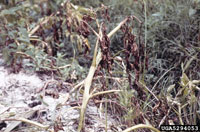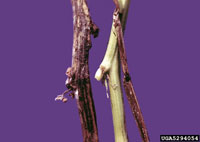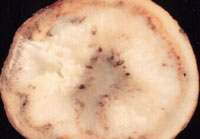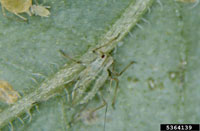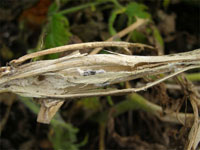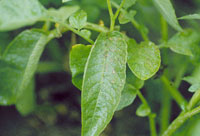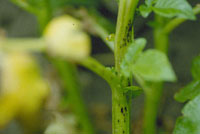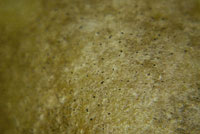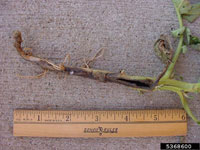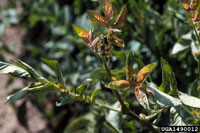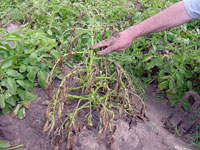Extension > Garden > Diagnose a problem > What's wrong with my plant? > Vegetable > Potato > Leaves yellow and wilt
Potato > Leaves > Leaves yellow and wilt
1 of 6
Verticillium Wilt
Verticillium spp.
- Leaves turn yellow then brown and wilted, stems remain erect
- Symptoms are often seen on one or a few stems but not the entire plant
- Often only random plants scattered in the field are affected
- If the stem is cut near the soil line, brown streaks or rings can be seen just under the skin
- Dark brown to black streaks or rings can be seen in the tuber flesh if cut on the stem end
- More information on Verticillium Wilt
2 of 6
Potato Aphid and Green Peach Aphid
Macrosiphum euphorbiae and Myzus persicae
- Feeding by small or moderate numbers of aphids usually does not cause visible symptoms
- Feeding by larger numbers of aphids can cause curling, stunting, and wilting of leaves
- Active during spring and summer
- 1/10th inch long
- Small insects, pear-shaped, usually greenish; clustered on underside of leaves
- More information on Potato Aphid and Green Peach Aphid
3 of 6
White Mold
Sclerotinia sclerotiorum
- Leaves wilt but remain green
- Elongated tan dry lesions form on stems
- Fluffy white fungal growth and small hard black fungal sclerotia can be found on or in infected stems
- More information on White Mold
4 of 6
Black Dot
Colletotrichum coccodes
- Leaves may have random brown spots, or may yellow and wilt due to infection of stem and roots
- Irregular patches of gray discoloration on surface of the potato tuber
- Sunken dark brown to black lesion on stem that turns white in the center with age
- Many pinprick sized black dots can be seen on infected stems and tubers (handlens is helpful)
- More information on Black Dot
5 of 6
Blackleg and Soft Rot
Pectobacterium carotovora
- In severe cases, plant is stunted, with yellow and wilted leaves
- Seed potato may rot in the soil, plants do not emerge
- Brown to black slimy sunken lesions on stems, most common starting at the soil line
- Tuber flesh is white, soft and rotted. In severe cases the entire tuber rots away, leaving on the skin
- Favored by cool wet weather
- More information on Blackleg and Soft Rot
6 of 6
Zebra Chip
Candidatus Liberibacter spp.
- Aerial tubers form from main stem
- Leaves may be purple or yellow, appear scorched, and wilt
- Inside of potato is a mottled brown
- Vectored by the potato psyllid
- Currently not found in MN. If suspected, report it to the Minnesota Department of Agriculture at the "Arrest the Pest" Hotline: 651-201-6684 (metro) or 1-800-545-6684 (Greater Minnesota)
- More information on Zebra Chip



